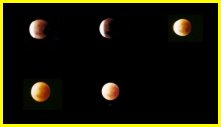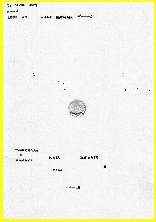






Total lunar eclipses are a fairly frequent occurence, although inevitably few are blessed by good weather. The Moon is lit by light from the Sun reflecting on its surface. At New Moon, it lies on the Sun side of the Earth so we do not see it. Sometimes when the Moon is but a tiny sliver you may see the 'dark' area lit by 'Earthshine', sunlight reflected from the Earth, onto the Moon and back to us. At mid lunar cycle we see a half Moon, and at Full Moon all of it. The Earth does not always come directly between Sun and Moon but when it does its shadow causes a lunar eclipse. The Moon is not completely hidden, but usually turns a deep red.
Eclipses are easy to photograph. Use a fairly fast film, set the camera on a tripod and 'bracket' exposures, that is, take several shots at different exposures at the same time and you should get one that is 'right'. Once the Moon is completely eclipsed, however, you will probably find that the exposure time will be long enough for the Moon to move during it, causing a trailed image. To say that the Moon moves is of course not quite correct. It only appears to move, since it is actually the Earth which does the moving. The second set of images above was taken with some cloud, which has added some interesting effects.
Conjunction is the name used when two or more astronomical objects move close together. Of course they often don't really move close together - they just appear to. This was the case when on March 25th 2004 Mars and Venus lay close to the crescent Moon. What made this a memorable conjuction was the close proximity of the Pleiades and Hyades, the two star clusters of Taurus.
Exactly 8 years later the crescent Moon made another stunning ensemble with Venus and Jupiter. As the two planets parted from their own close encounter the Moon passed Jupiter on March 25th 2012 and Venus the following night. See the 'Venus Jupiter conjunction' page for these images.